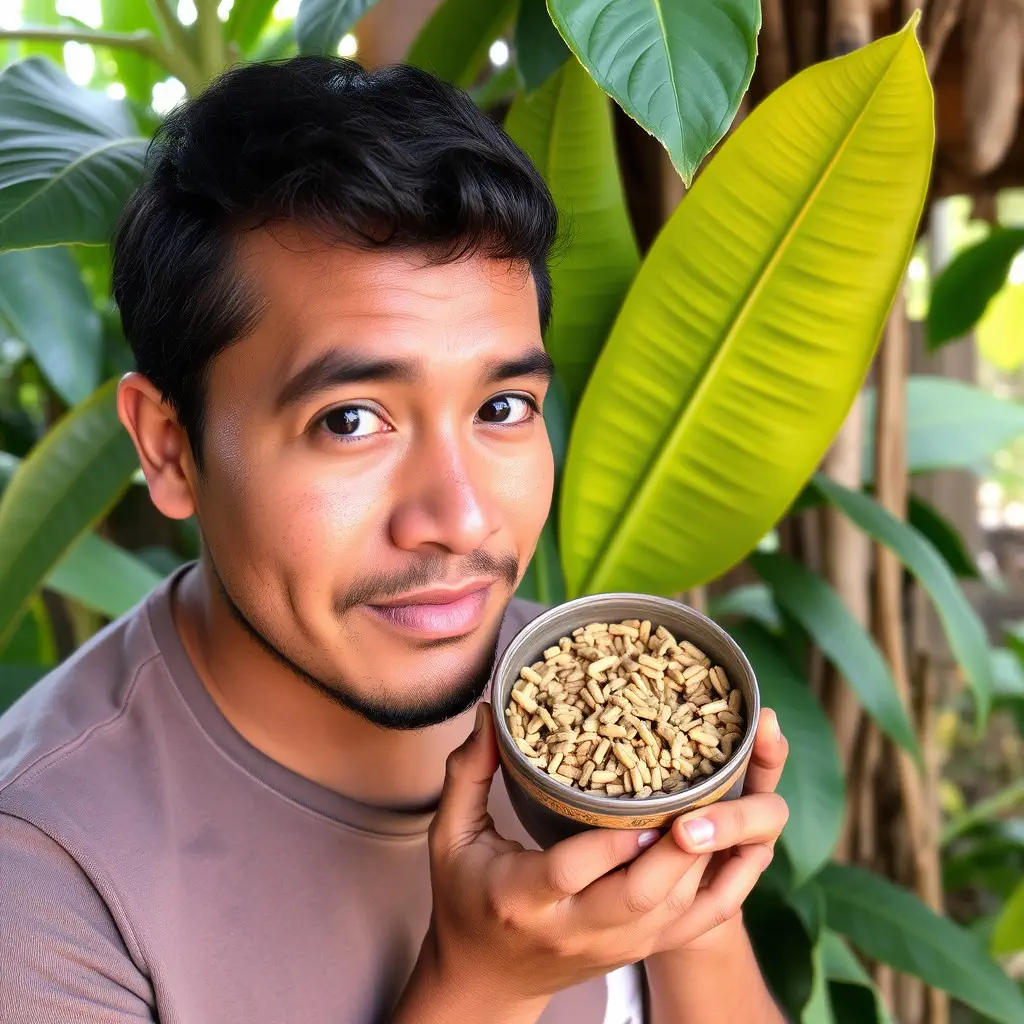Maeng Da Kratom Powder, a potent strain from Southeast Asia's forests, is renowned for its unique alkaloid profile that includes significant levels of 7-hydroxymitragynine. This strain offers a blend of stimulating and soothing effects, which can be beneficial throughout the day. The inclusion of barberry root tea, rich in berberine, may complement Maeng Da's effects for enhanced wellness support. While both substances have potential health benefits, it is essential to approach their use with caution, starting with a low dosage and consulting healthcare professionals, especially considering their interactions and the importance of staying within safe limits. The synergy between Maeng Da Kratom and barberry root tea may provide antioxidant benefits and support overall health. For those interested in incorporating these into their wellness routine, it is advised to consume them separately with meals for optimal absorption and to be mindful of individual responses, staying hydrated and monitoring any interactions that occur. This balanced approach ensures a safe and effective way to explore the potential health benefits of Maeng Da Kratom Powder and barberry root tea.
Discover the unique properties of Maeng Da Kratom Powder, a botanical substance renowned for its potent effects. This article delves into the nuanced alchemy of how Maeng Da interacts with the human body, offering insights into its influence on well-being. Additionally, explore practical ways to incorporate this powerful agent into your daily routine, including the synergistic benefits when paired with barberry root tea. Join us as we navigate the intricacies of Maeng Da’s role in promoting balanced health and enhancing daily vitality.
- Unveiling the Potency of Maeng Da Kratom Powder: An Overview
- The Alchemy of Effects: How Maeng Da Interacts with the Body
- Integrating Maeng Da into Your Routine: Dosage and Complementary Practices, Including Barberry Root Tea
Unveiling the Potency of Maeng Da Kratom Powder: An Overview

Maeng Da Kratom Powder, hailing from the Mitragyna speciosa tree, is celebrated for its distinctive potency and a wide array of effects that set it apart from other kratom strains. This strain, often referred to as “Pimp Grade,” has garnered attention in herbal supplement circles for its robust alkaloid profile, particularly the presence of 7-hydroxymitragynine, which is thought to contribute significantly to its potent effects. Users often report a blend of stimulating and soothing sensations, making it a versatile choice for those seeking both energy and relief from discomfort. The experience with Maeng Da can vary depending on dosage and individual physiology, with some users favoring its invigorating properties in the morning or during physically demanding tasks, while others prefer it for its calming effects later in the day.
When considering alternative supplements to complement Maeng Da Kratom Powder, barberry root tea emerges as a noteworthy option due to its similarities in the realm of herbal remedies. Barberry root, rich in berberine alkaloids, is known for its potential benefits in supporting overall health and well-being. Its inclusion in some users’ regimens may synergize with the effects of Maeng Da Kratom, offering a holistic approach to health maintenance. As with any herbal supplement, it is advisable to consult with a healthcare professional before integrating barberry root tea into one’s routine, especially when used concurrently with kratom, to ensure safety and appropriateness for individual needs.
The Alchemy of Effects: How Maeng Da Interacts with the Body

Maeng Da Kratom, a strain originating from the verdant forests of Southeast Asia, has garnered attention for its distinctive alkaloid profile and potent effects. The alchemy of Maeng Da’s interactions with the body is a complex dance between these alkaloids and various physiological systems. When ingested, the alkaloids found in Maeng Da, such as mitragynine and 7-hydroxymitragynine, engage with receptors throughout the body, influencing mood, pain perception, energy levels, and cognitive function. This unique blend of compounds is believed to contribute to the strain’s widespread use for well-being and health support, often as an alternative to barberry root tea, which is also revered for its healing properties.
The effects of Maeng Da are characterized by a fine balance between stimulation and relaxation, a duality that many users find particularly appealing. The stimulating effects can lead to increased focus and motivation, making it a popular choice among individuals seeking an energy boost without the jittery side effects associated with traditional caffeinated beverages or synthetic stimulants. Concurrently, its relaxing properties can alleviate stress and promote a sense of calm, often aiding in the management of anxiety and promoting better sleep quality when taken in appropriate doses. This balance is further complemented by Maeng Da’s potential synergy with adaptogenic herbs like barberry root tea, which similarly promotes homeostasis within the body. Users who incorporate both Maeng Da and barberry root tea into their wellness routine may experience enhanced overall vitality, as each contributes to different aspects of bodily functions and health maintenance.
Integrating Maeng Da into Your Routine: Dosage and Complementary Practices, Including Barberry Root Tea

Maeng Da Kratom powder, renowned for its potent alkaloid profile, can be a valuable addition to your daily wellness routine when integrated thoughtfully. To incorporate Maeng Da into your regimen, it’s crucial to start with a measured dosage based on your individual tolerance and experience with kratom. Typically, a moderate starting point for experienced users is one to two grams taken orally, which can be adjusted as needed and with caution. As you become accustomed to its effects, you may increase the dosage incrementally, not exceeding a higher threshold of five to seven grams for seasoned users. It’s advisable to consider your body’s response and avoid overconsumption, especially if you are new to kratom.
Complementary practices can amplify the benefits of Maeng Da when used in conjunction. For instance, pairing it with barberry root tea can offer synergistic effects. Barberry root tea is rich in alkaloids similar to those found in kratom, such as berberine, which may contribute to supporting overall well-being and health. The combination of Maeng Da with the antioxidant properties present in barberry root tea can potentially enhance your body’s resilience against oxidative stress and promote a balanced mood. To ensure optimal results, it’s recommended to consume these two supplements at different times throughout the day, preferably with meals to aid in digestion and maximize absorption. Always stay hydrated and monitor how your body interacts with this combination, as individual responses can vary greatly. Remember to consult with a healthcare provider before making any changes to your wellness routine, especially when incorporating new supplements like Maeng Da Kratom and barberry root tea into your daily life.
Maeng Da Kratom Powder stands out as a noteworthy subject due to its distinctive potency and the multifaceted effects it can produce within the body. Its alchemical interaction with physiological processes offers a unique experience for those who partake in it, making it a topic of growing interest among wellness enthusiasts. When incorporating Maeng Da into daily routines, careful consideration of dosage and complementary practices, such as consuming barberry root tea, can enhance its benefits. This synergy underscores the importance of holistic approaches to well-being, highlighting how traditional remedies can be harmoniously integrated with modern health practices. As research continues to evolve, Maeng Da Kratom Powder remains a compelling topic for exploration and responsible use within the realm of natural supplements.






